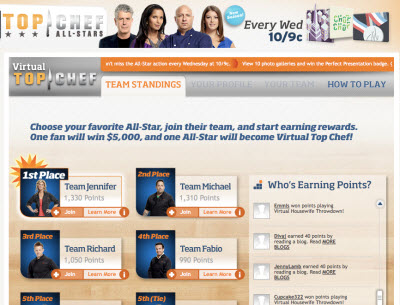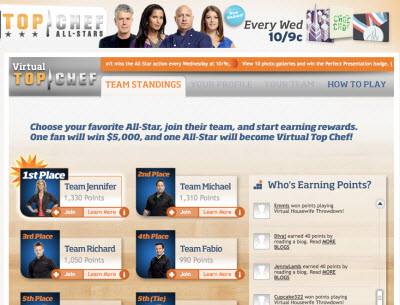 Bunchball has raised a round of $6.5 million to expand its investments in gamification, or using game-like mechanics to increase consumer engagement with non-game web sites.
Bunchball has raised a round of $6.5 million to expand its investments in gamification, or using game-like mechanics to increase consumer engagement with non-game web sites.
The announcement is another sign that gamification is trendy among investors. Bunchball is one of the oldest gamification companies, and funding suggests that it is getting more traction in the market. The company says it has doubled its customer base over the past year.
Jim Scullion, chief executive of the San Jose, Calif.-based company, said in an interview that the company wanted to fill its coffers so it can invest in further developing the gamification market, including a push in enterprise deals. The company will use the money to invest in product development, marketing and sales and expand into business-to-business, loyalty and incentive markets.
The funding came from Triangle Peak Partners, Northport Investments, Correlation Ventures and Granite Ventures. To date, the company has raised $17.5 million in venture funding. Adobe Systems, a prior investor, did not participate in the round.
“We have been getting traction since 2010, and we are seeing growth in the enterprise,” Scullion said. “We signed a deal with a major tech company recently. We have doubled our customer acquisition over the last six to nine months.”
Michael Morgan, co-founder at Triangle Peak, said that Bunchball has emerged as the leader in gamification in the past 12 months.
 Bunchball has 33 employees now and hopes to have 55 by 2012. Bunchball has been working at gamifying web sites since 2005, and its latest efforts show that it is able to keep users more engaged with a brand than they otherwise might be. Gamification is generating both buzz and skepticism as a hot new trend in games, extending games in a new direction just as social network games and mobile games have done. Big corporations are starting to embrace gamification, and if it works, those companies will be able to use game-like behavior to get people more engaged in their brands and products.
Bunchball has 33 employees now and hopes to have 55 by 2012. Bunchball has been working at gamifying web sites since 2005, and its latest efforts show that it is able to keep users more engaged with a brand than they otherwise might be. Gamification is generating both buzz and skepticism as a hot new trend in games, extending games in a new direction just as social network games and mobile games have done. Big corporations are starting to embrace gamification, and if it works, those companies will be able to use game-like behavior to get people more engaged in their brands and products.
Rajat Paharia, founder and chief product officer of Bunchball, said in a recent interview that Playboy, which is out to get more young subscribers, has been able to use Bunchball’s Nitro platform to power a Facebook app called Miss Social. It’s a month-long competition where any woman who aspires to be in Playboy can get her friends to vote for her. If she succeeds, she is crowned Miss Social for a month and can get a pictorial (clothed or not) on Playboy.com.
Women submit their photos and have to win more votes on a given day of the month than anyone else. Users can engage in a variety of activities on Facebook to generate more votes. Then the women can encourage their friends to save up their votes for a particular day. The result of the Bunchball gamification has been an 85 percent rate of re-engagement and a 60 percent improvement in revenues from one month to the next.
“We’ve seen huge growth in gamification over the past year and we’re thrilled to see that translate into genuine customer demand,” Paharia said.
The gamification efforts can be full custom jobs or small efforts. In the case of Playboy, marketing firm IMHO Media created the app and used the Bunchball platform. So it required very little extra effort from Bunchball before it started generating revenue. By contrast, some companies pay Bunchball fees to create custom jobs, such as a game that Bunchball created for Bravo TV’s Top Chef All-Stars TV show (pictured at top).
Bunchball’s customers include ABC, CBS, NBC, Bravo, USA Network, SyFy, Warner Bros., Comcast and Telemundo in the TV space. It also teamed with Chiquita and Twentieth Century Fox to create a gamified cross-promotion campaign — where users get a chance to win prizes based on their engagement in the campaign — around the hit movie Rio. And it has worked with a bunch of companies across the retail, corporate, and health sectors to integrate game mechanics into broader company campaigns and loyalty programs.
On average, Bunchball says, Nitro users see page views double, page views per visit increase 60 percent, unique visitors increase 30 percent, time on site increase 100 percent, and repeat monthly visits double. The result is a 400 percent return on investment with a payback time of as little as three months. Today, Bunchball reaches more than 70 million users per month across its customers’ web sites.
That all sounds pretty good. In the macro picture, there are a lot of gamification bulls. Market research firm Gartner says that 50 percent of companies will embrace gamification by 2015. Market analyst firm M2 Research estimates that revenue from the production of gamification projects will grow from $100 million in 2011 to $1.6 billion, or 23 percent of social media marketing budgets, by 2015. The Gamification Summit drew a big crowd in January. Gamification experts Gabe Zichermann and Amy Jo Kim are doing regular gamification workshops.
But gamification has seen some backlash as well, says Tim Chang, principal at Norwest Venture Partners. Speaking at a recent SF Game Developers Workshop talk, Lightspeed Venture Partners managing director Jeremy Liew said he believes gamification won’t work on activities that are fundamentally not fun, like exercising more and eating less.
But Paharia says he disagrees. Research shows that there are very different motivators for work. The No. 1 thing that makes people feel like they had a good day is making progress at work, Paharia said. The second most valuable thing is recognition, he said. Gamification offers something on both of those fronts in providing incentives that are more powerful than dollars, Paharia said.
If there’s an explanation for why gamification is hot, it might be a natural successor to free-to-play and social games. Free-to-play games — where users play for free and then pay real money for virtual goods such as better weapons in a game — took off on Facebook, allowing apps to build up huge numbers of users. If just a few percent pay for the app, then that generates enough revenue to offset the costs of the non-paying users, and it’s usually enough to make the app profitable. Social games have trained people to appreciate virtual goods, virtual currency, and leveling up. Right now, 120 million people around the world are accruing points, leveling up and earning rewards.
Gamification is pretty much a collection of all of the tricks and tips needed to motivate those users to move from the casual, unengaged user to the paying, enthusiastic and engaged user in non-game apps. Getting users to take actions that move them on the path toward paying is what Bunchball does, and it is now getting users to do about 2.5 billion of those actions per month, Paharia said.
That’s why there’s a dozen or so companies (Big Door, BadgeVille, Gamify and others) in the gamification market now. In terms of revenues, users reached, and customer base, Paharia said that Bunchball is the biggest. In the future, Paharia believes that gamification will move beyond consumer markets into the enterprise, as companies gamify their processes to get employees more engaged. Paharia said there are a number of such enterprise projects already underway at Bunchball.
Bunchball has 31 employees.
 We’ll be exploring the most disruptive game technologies and business models at our third annual GamesBeat 2011 conference, on July 12-13 at the Palace Hotel in San Francisco. It will focus on the disruptive trends in the mobile games market. GamesBeat is co-located with our MobileBeat 2011 conference this year. To register, click on this link. Sponsors can message us at sponsors@venturebeat.com. To participate in our Who’s Got Game? contest for the best game startup, click on this link.
We’ll be exploring the most disruptive game technologies and business models at our third annual GamesBeat 2011 conference, on July 12-13 at the Palace Hotel in San Francisco. It will focus on the disruptive trends in the mobile games market. GamesBeat is co-located with our MobileBeat 2011 conference this year. To register, click on this link. Sponsors can message us at sponsors@venturebeat.com. To participate in our Who’s Got Game? contest for the best game startup, click on this link.
VentureBeat's mission is to be a digital town square for technical decision-makers to gain knowledge about transformative enterprise technology and transact. Learn More

